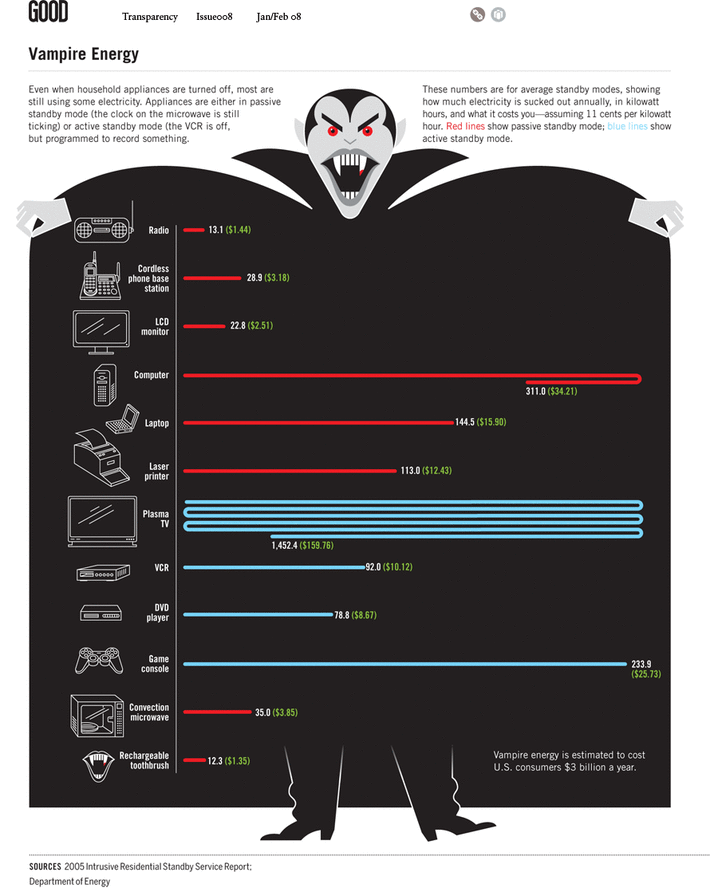

| Online: | |
| Visits: | |
| Stories: |

| Story Views | |
| Now: | |
| Last Hour: | |
| Last 24 Hours: | |
| Total: | |
Vampire Power, Electronics Turned Off Still Cost You Money
The villain in question is vampire power, also known as standby power and phantom load, from what is called a vampire device. You can also find it referred to as vampire energy, leaking energy, wall warts, standby loss, idle current, phantom power, ghost load, ghost charge, and vampire load. The terms refers to the electricity many gadgets and appliances waste just by being plugged in (even if they’re switched off). After all, what do you think your cell-phone charger does all day while it’s plugged into the wall? If it’s warm when you get home from work, then it’s been using electricity — even if it had nothing to charge.
Individually, your rechargeable electric toothbrush may not put that much strain on the local power plant, but the big picture is far more troubling. In the United States alone, vampire power costs consumers more than $3 billion a year [source: Energy Information Administration]. Over time, many microwaves and televisions actually consume more electricity during the hours they’re not in use than the times you’re actually using them to heat up dinner and watch your favorite show.
How do you fight off the ravages of vampire power? In this article, you’ll learn why this energy loss happens and how to slay it once and for all.
 Vampire Energy Chart – GoodMagazine.com
Vampire Energy Chart – GoodMagazine.com
Coincidentally, GOOD Magazine has created this handy chart that graphically depicts the impact.
The real surprise on it is plasma TVs–who knew they were sucking so much energy when “off”? And that game console of yours? It’s costing you $25 a year just sitting there, even when you’re not using it. Have more than one console? Well, do the math…
The chart does not include all the wall-warts for cell phones, laptops, cameras, and the like that tend to stay plugged into the wall (and consuming some amount of electricity) even when not actually charging their devices. By some estimates these are responsible for 4 percent of all U.S. electricity consumption, equivalent to almost 100 million tons of oil. Hmm, no wonder the U.S. is 5 percent of the world’s population but consumes 23 percent of its energy…
In the average U.S. home, 25 percent of electricity use by home electronics occurs while the products are off [source: Pogue]. Is this power used for anything? Do electronics manufacturers hate the environment?
Vampire power causes usually include one of the following:
- The gadget, such as a cell-phone AC adapter, constantly supplies a charge, even if the batteries are fully charged or if nothing is plugged into it. Many AC adapters, nicknamed wall warts by some critics, waste as much as 50 percent of the power they use [source: Office of the Ohio Consumers' Council].
- The gadget uses electricity to power a display screen, an external time display or an internal clock. In some cases, this power usage is justified. For instance, your refrigerator needs to monitor temperature levels in order to power up at appropriate times. When it comes to your radio however, it’s not as easy to justify a constant power drain to keep the digital clock lit.
- The gadget never fully shuts down so that it’s ready to use at a moment’s notice. Many printers spend hours in standby mode, waiting to receive signals from connected computers. Before you even pick up your remote control, the TV is already using electricity to power the sensor that will receive the signal.
Vampire power has been on the rise during the past decade, thanks to the proliferation of rechargeable gadgets, computer networks and devices with standby power functions. The United States consumes 26 percent of the world’s energy. Of that energy, approximately 5 percent is vampire power [source: University of California, Berkeley]. To put that in perspective, that’s between 200 and 400 terawatt hours — roughly as much electricity as the entire country of Italy consumes in a year [source: Smyth].
All this energy use enacts quite a hefty toll on the environment. Coal-burning power plants produce carbon dioxide, a leading cause of global climate change. Therefore, less vampire power translates to lower carbon emissions. Even plants that run on nuclear or hydroelectric power produce emissions that can lead to smog and acid rain.
Want to know how to help the environment and save a little money on your power bill in the process? Pick up a few vampire-fighting tactics and a few online resources below!
 FACT: You spend about $159 a year on standby power alone.
FACT: You spend about $159 a year on standby power alone.
Ready to pick up your stake, take a stab at saving electricity and fight vampire power? Lucky for you, the battle against this energy waster comes down to two tactics:
- Identify which electronic devices drain power when not in use.
- Replace these electronic items with energy-efficient devices or cut off power when you aren’t using them.
If you’re not using an electronic device, unplug it — that’s the blanket approach to fighting vampire power. You can make this step even easier with a surge protector or power strip. Plug multiple items in the strip and simply turn it off when you’re not using the devices. If the strip is off, you don’t have to worry about leaking electricity.
A certain amount of standby power is unavoidable, especially with major appliances or other devices that are impractical to turn off. But this doesn’t mean vampire power can’t be kept to a minimum. Many electronic devices waste power in standby mode due to poor design. Purchase energy-efficient products and you’ll waste less electricity on standby functions. The governments of the United States, Canada, Japan, New Zealand, Taiwan and the European Union all regulate energy-saving products and label them as Energy Star-certified products. These products are guaranteed to meet certain low-energy consumption criteria.
Electronic devices may cause vampire power, but there are also a number of gadgets on the market designed to help cut down on unnecessary power loss. The Kill A Watt digital wattage reader from P3 International allows you to check how much power your electronic devices are consuming.
Other products take the energy-saving potential of surge protectors to the next level. Watt Stopper/Legrand’s Isolé plug load controller basically combines a typical surge protector with a motion detector. The surge protector consists of six occupancy-controlled outlets that power off when there’s no motion in the room for a set amount of time (programmable between 30 seconds and 30 minutes). Two uncontrolled outlets still remain on. All you have to do is plug vampire electronics or lights into the occupancy-controlled outlets and plug items you don’t want randomly shutting off into the uncontrolled outlets.
Other power strips (such as the Smart Strip Power Strip or the Power-Saving Essential SurgeArrest 7) feature a master-slave arrangement, similar to the set up of many electronic devices. If you aren’t using your computer, why have power traveling to your speakers, printer and other accessories? The smart strip lets you designate one device as the “master” and several secondary devices as “slaves”. If the master device is off or drawing only standby power, then the slave outlets don’t get any power either.
All these weapons may seem useless against the billions of dollars worth of vampire power that flows through power lines each year. But if enough people become aware of the problem and take steps to prevent it, a vast amount of power and natural resources can be better used.
Shown below is a list of typical household appliances along with the annual cost you could be wasting by leaving them plugged in when they are not in use (the list was created by The Conscious Consumer along with the Lawrence Berkeley National Laboratory and the American Council of Energy-Efficient Economy, and it assumes electricity cost of 11 cents/kwh):
Digital cable box with DVR $43.01
DVR $36.63
Set-top satellite box with DVR $27.52
Digital cable box $17.65
Satellite cable box $15.50
Laptop computer $8.81
Multifunction printer, scanner, copier $5.21
CD player $4.99
VCR $4.38
Desktop computer $3.96
Power tool $3.96
Microwave oven $3.05
LCD TV $2.97
Plasma TV $2.97
Handheld vacuum $2.97
Answering machine $1.99
Printer $1.98
Computer speakers $1.98
Answering machine $1.99
Printer $1.98
Computer speakers $1.98
Cordless phone $1.98
Electric toothbrush $1.98
Portable stereo $1.64
DVD $1.53
LCD monitor $1.12
Coffee maker $1.12
AM/FM tuner $1.11
CRT TV $1.00
Video game console $1.00
Cell phone charger (unattached to phone) $0.26
If you add up the items that are found in a typical home (one for each category) you will find that you may be very well paying nearly $100 per year in wasted standby electricity. With the information above and the links below, you should be better equipped to take on any and all Vampire Devices that may be lurking in your home.
More Great Links
- Energy Star
- U.S. Department of Energy
- U.S. Energy Information Administration
- http://www.pickocc.org/publications/electric/Vampire_Power.pdf
Sources
- Aquino, Grace. “Seven Ways to Cut Your Electric Bill.” Bloomberg News. May 1, 2008. (May 23, 2008) http://www.bloomberg.com/apps/news?pid=20601093&sid=aKx01f1zb64Q&refer=home
- Clean Air Online. “Electricity Generation.” Environment Canada. Nov. 20, 2006. (May 22, 2008) http://www.ec.gc.ca/cleanair-airpur/Electricity-WSDC4D330A-1_En.htm
- Dunn, Collin. “TreeHugger Picks: Cut Back on Phantom Power.” TreeHugger.com. Dec. 6, 2006. (May 23, 2008) http://www.treehugger.com/files/2006/12/cut_back_on_pha.php
- Energy Information Administration. “Did You Know that Energy Vampires Lurk in your House?” Energy Kids Page (May 23, 2008) http://www.eia.doe.gov/kids/classactivities/energyarticles.html#energyvampires
- Energy Star. “International Partners.” (May 22, 2008) http://www.energystar.gov/index.cfm?c=partners.intl_implementation
- Good Magazine. “Vampire Energy.” January 2008. (May 23, 2008) http://awesome.goodmagazine.com/transparency/008/trans008vampireenergy.html
- Gordon, Jacob. “Another Stake Through the Heart of Vampire Power.” TreeHugger.com. Nov. 18, 2006. (May 23, 2008) http://www.treehugger.com/files/2006/11/another_stake_through_the_heart.php
- Jeantheau, Mark. “Vampire Power.” Grinning Planet. October 2007. (May 23, 2008) http://www.grinningplanet.com/2004/10-26/vampire-power-electricity-article.htm
- Karp, Gregory. “Vampire appliances: plugged in, sucking power.” Newsday. May 4, 2008. http://www.newsday.com/business/yourmoney/ny-bzcov045671788may04,0,3572442.story
- Meier, Alan and Alain Anglade. “Global Implications of Standby Power Use.” The Proceedings of ACEEE Summer Study on Energy Efficiency in Buildings. June 2000. http://www.osti.gov/bridge/servlets/purl/789121-dxnR5R/native/789121.pdf
- Office of the Ohio Consumers’ Counsel. “Learn about vampire power.” October 2007. (May 23, 2008) http://www.pickocc.org/publications/electric/Vampire_Power.pdf
- Oppenheim, Leonora. “Vampire Power.” TreeHuggerTV. Oct. 31, 2006. (May 23, 2008) http://www.treehugger.com/files/2006/10/treehuggertv_vampire.php
- Pogue, David. “Reducing the Amount of Juice Electronic Gadgets Consume.” The New York Times.” April 24, 2008. http://www.nytimes.com/2008/04/24/technology/personaltech/24pogue-email.html
- Smyth, Julie Carr. “Electronic vampires suck energy, not blood.” USA Today. Oct. 30, 2007. http://www.usatoday.com/tech/products/2007-10-30-vampire-electronics_N.htm
- University of California, Berkeley Student Sustainability Education Coordinators. “Phantom Load.” University of California, Berkeley. (May 23, 2008) http://www.ocf.berkeley.edu/~recycle/ssec/download/Phantom%20Load.pdf
- United States Department of Energy. “How to Buy Products with Low Standby Power.” June 2004. (May 23, 2008) http://www1.eere.energy.gov/femp/pdfs/standby_power.pdf
- Watt Stopper/Legrand. “Watt Stopper/Legrand’s unique plug load controls save energy and can contribute to LEED credits.” May 2008. (May 22, 2008) http://www.wattstopper.com/pressroom/news.html?id=161
- What is the cost of “vampire energy”? – http://news.cnet.com/8301-13641_3-9833475-44.html
- How Vampire Power Works – http://electronics.howstuffworks.com/everyday-tech/vampire-power.htm
- Vampire Hunting at Home – http://sustainable-edmonds.org/2011/07/vampire-hunting-at-home/
- TWILIGHT: “The Electricity Vampires in Your Home” – http://www.home-wizard.com/how-to-guide/other-home-safety-savings/energy-audits/articles-videos/electricity-vampires.aspx
- The PumPing: popping plugs to save power – http://blog.nothingbutsoftware.com/2012/01/the-pumping-popping-plugs-to-save-power/
Source: http://www.apparentlyapparel.com/news/vampire-devices-sucking-energy-while-you-sleep



